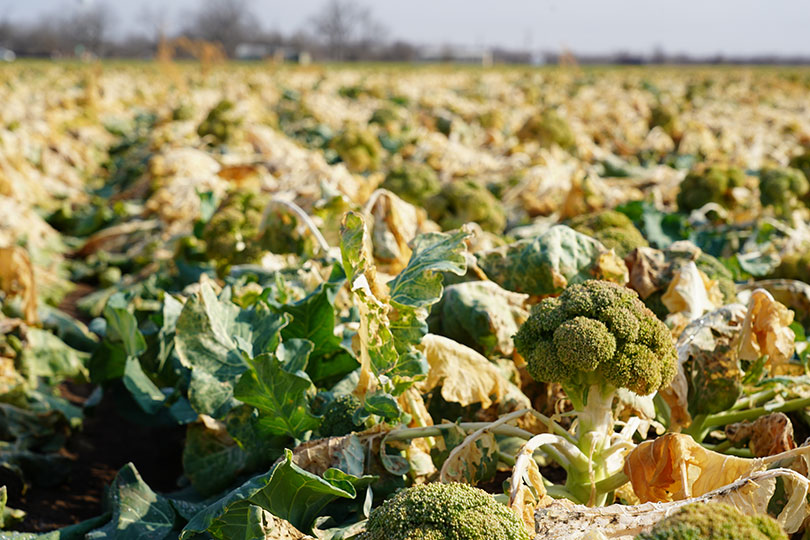By Julie Tomascik and Jennifer Whitlock
In February, extreme cold weather devastated agriculture in the Lone Star State. The winter storm system stretched from the Texas Panhandle to the Rio Grande Valley, and from Far West Texas into East Texas, clutching every county of the Lone Star State in an icy embrace for several days. Temperatures were as low as -20 at the Palo Duro Reservoir in Hemphill County, with readings in the teens and lower 20s as far south as the Rio Grande Valley and negative readings as far south as Central Texas.
We bring you some of the stories of Texas farmers and ranchers who braved the bitter cold and deep freeze. We don’t yet know the magnitude of what the storm will cost Texas farmers and ranchers, but we have seen stories of hard work, hope, compassion and neighbors helping neighbors. And the beating heart of Texas agriculture is the people.

Chelsea Sage
At the very top of Texas, temperatures dropped. Fast. The cold settled in for over a week, bringing frigid weather to an area of the state that’s used to snow and cold.
In Texline, Austin and Chelsea Sage watched the weather, like any farm and ranch family does. They saw the predicted temperatures. But nothing can truly prepare a Texan for cold like what they experienced. The low was -14, and the area spent a week at below-freezing temperatures.
“We’re used to cold, but we’re not used to it getting that cold for that long,” Chelsea said. “But we do what we have to do—no matter the weather. It’s just what farmers and ranchers do. No one ever said it would be easy, and it’s definitely not easy when we face weather like this. But somehow, we find a way to stay strong.
We get the job done, because we have to.”
For the Sages, the job was chopping ice and feeding hay. Fortunately, their cows didn’t start calving until the week after the storm.
“Compared to others up here and aroud the state, we were very fortunate with how we fared and how our livestock fared,” she said. “We didn’t lose any cattle. It could’ve been much worse for us, and it was for so many families.”
They won’t begin planting corn until mid-April, so the little moisture that the snow and ice brought was beneficial for the area that’s been in drought for several months.
“Farmers and ranchers are made strong. This storm wasn’t good for any of us, but somehow we will all make it. We have to,” she said.
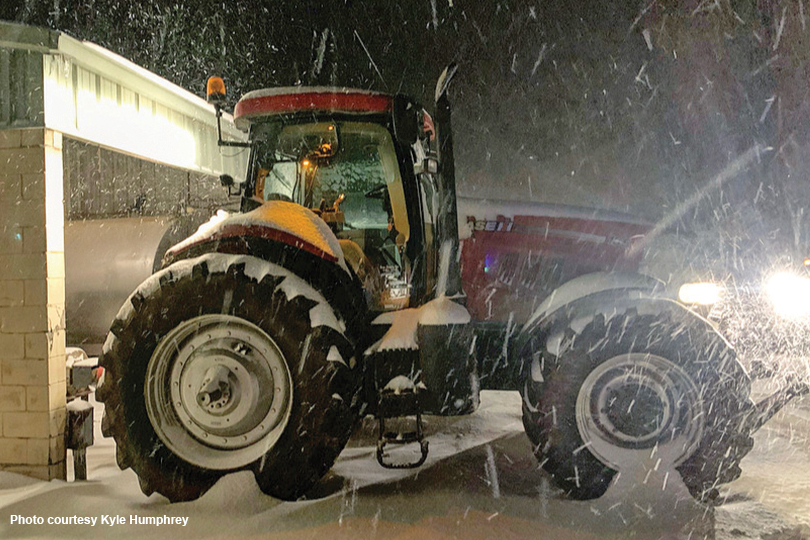
Kyle Humphrey
Preparations began the week before the storm for Kyle Humphrey and his family on their dairy farm in East Texas. They hung tarps to help keep heat in the barns and stacked hay bales as a wind break. They put plywood along some fences, too.
The temperature kept dropping until it eventually reached -2 degrees, but it really felt like -12.
“That’s what my phone said, and it was cold. We tried to make sure nothing froze, and we could keep milking,” he said.
They had one delay on Monday. It took them about an hour to determine one of the sensors on the vacuum lines had ice on it. And the rolling blackouts could have spelled trouble for the dairy, but they had a tractor ready to run the generator just in case.
“The blackouts started at 2 a.m. on Monday. After we figured out what was going on, we started the tractor and the generator and ended up running it for 103 hours straight,” Humphrey said. “Our power did eventually come back on, but we still left the tractor and generator running just to be sure.”
In many of their pastures, they have water troughs that are plumbed from the underside. Without any exposed water lines, nothing froze and their cows in those pastures had access to water.
But in other pastures, they had to haul water or chop ice.
That wasn’t the only issue they faced, though. Icy roads meant milk trucks couldn’t make it to the dairy, and the Humphreys had to dump their milk. About 150,000 pounds, which is about 21,000 gallons of milk, never made it to its destination.
“I don’t know how to explain it. I’ve seen us dump milk for other reasons, but seeing it because of a snow storm was surreal,” he said.
They also lost a few of their beef and dairy cows due to the challenging weather.
“It was a pretty exhausting and stressful week. If we had any less people helping us, I don’t know how we would have managed,” he said. “I’m pretty thankful for how things went.”
They learned a lot, too.
“Next time, we’re going to be even more prepared. We’ll buy more heaters to have on hand,” he said. “We do plan to put in some more water troughs that are fed from the bottom side. That way, hopefully next time, we won’t have to haul as much water.”

Dale Murden
Wilted plants. Browned leaves. Black buds that would have been next year’s fruit. That’s what’s left for many citrus growers like Dale Murden in the Rio Grande Valley.
They did their best to prepare for the cold spell, but it wasn’t enough.
“The wind was so strong that a lot of the irrigation freezing methods that we do with micro sprinklers and sprinkler systems just weren’t that effective because the wind was blowing so hard,” Murden, a former Texas Farm Bureau District 13 state director, said. “But then the other side of it is you get down to 21 degrees, and you’re only going to warm the tree up a few degrees anyway.”
Grapefruit harvest was about 55 percent complete when the cold weather hit, rendering the remaining fruit on the trees frozen and useless.
“This year has been an unusual year to begin with. We’ve been in a drought for several years now. Then, we had Hurricane Hannah, and we estimate we lost 10 to 20 percent of the crop at that time,” Murden said. “But all things considered, we were having a pretty good year. Prices were good. Quality was good, and the remaining fruit on the trees after the hurricane was good. Then, the ‘St. Valentine’s Day massacre’ hit, so you never know.”
To add insult to injury, the trees were beginning to bloom, which is the start of next year’s crop. So, one winter storm caused damage to two years’ crops.
But it could always be worse.
“We had big freezes in ’83 and ’89 where the temperature got down in the teens. We knew immediately we lost trees then,” he said. “This time, we don’t know yet what the damage to the trees is going to be. It’ll take a month or so to fully evaluate this.”
But no matter what Mother Nature throws at the Rio Grande Valley citrus growers and farmers, they’ll survive and keep farming.
“We’ll weather the storm and keep going. And South Texas grapefruit will still be here for you,” Murden said.
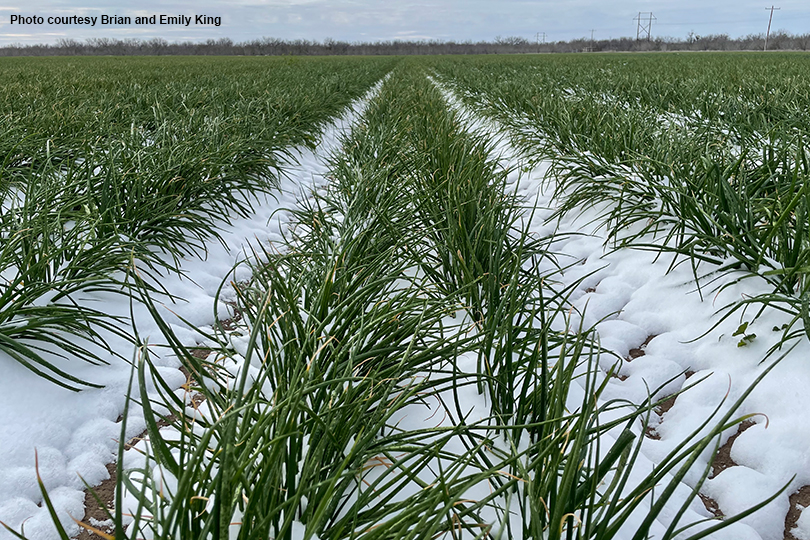
Brian King
Brian King feels fortunate. The onion transplants he grows at Dixondale Farms in Dimmit County mostly escaped damage.
When the weather forecasters began predicting an arctic blast, King and his crews started watering the plants thoroughly. Because plants that are well-watered are better able to withstand a freeze.
The Friday before the cold spell arrived, Dimmitt County also received a welcome half-inch of rainfall, giving the plants even more moisture. In another stroke of luck, the storm system dropped an inch of snow on top of the plants, insulating them from the freezing temperatures and helping keep the ground warmer underneath.
“We got down to 13 degrees with a wind chill of zero,” King, who is the production manager at Dixondale Farms, said. “Soil temperatures stayed about 40 degrees under the snow, so that helped us a lot. We haven’t experienced any weather like this since the late 1980s.”
One week after the icy blast, King was feeling pretty confident about the crop.
“I don’t think we’re going to lose more than 10 percent. We had a lot of frost damage on the top and leaves themselves,” he said. “Everything is fine, it’s just an appearance factor for our customers. Some of our plants’ leaves may not be that uniform dark green like they normally would be, but the plants are still hearty and healthy.”
King and his wife, Emily, have said many prayers for their neighbors, many of whom grow produce like spinach and cabbage.
“We’re in a lot better shape than a lot of our fellow farmers. A lot of people lost everything they had,” he said. “We’re getting things harvested and out the door, and we realize just how fortunate we really are in this situation.”
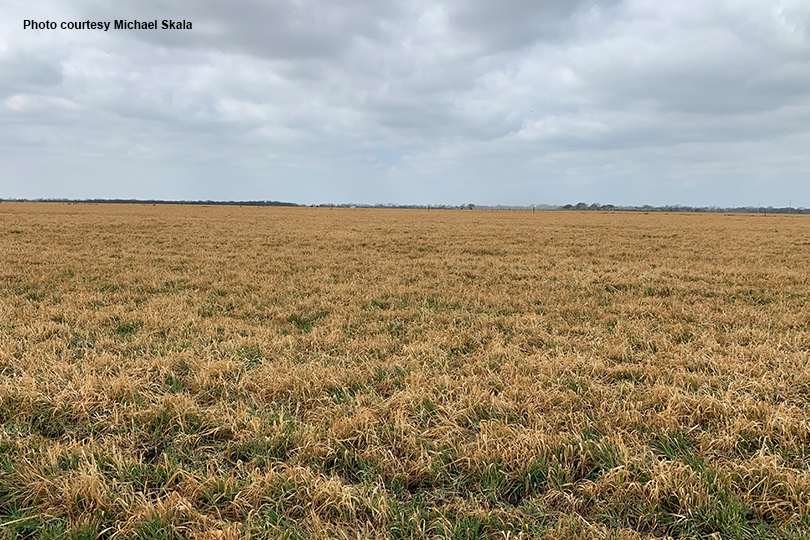
Michael Skala
Although he’s facing some losses in his oat fields grown for grazing, Michael Skala felt lucky to have escaped more damage to his crops and cattle.
“When the storm rolled in, it brought a layer of ice with it, so it iced over our wheat and then snow fell on it, basically creating an insulating layer. We have a little bit of leaf burn from the ice, but the entire week the wheat was pretty well protected from the cold weather,” Skala, a Falls County farmer and rancher, said. “Now it’s warmed up and the wheat has really taken off, and it’s outgrowing that leaf burn pretty quick.”
His grazing oats, however, didn’t fare as well. They have more leaf burn, but Skala hopes to get another month of grazing from the oats to help get the cattle through the spring.
“Otherwise we will be haying really heavy and putting feeders out, which can get expensive in a hurry,” he said.
Along with the coldest weather in recent memory, Winter Storm Uri brought a host of hardships to farmers and ranchers. It’s an experience Skala hopes to never have again.
“Our infrastructure is not built for that type of weather. Buildings aren’t built for it. Houses aren’t insulated for it. Our power grid went down from all the ice, and it was pretty bad. Everybody was prepared for a few days, but nobody was prepared for 10 days of it,” he said. “We were lucky we weren’t watering any livestock using public utilities. We have tanks in all of our pastures, but I know people who were watering livestock, and if you were on a public system and watering livestock, you were hauling water out of tanks and wherever you could find to get water to them. It got pretty tough. Hopefully, it’s a once-in-a-lifetime event that we won’t ever see again.”
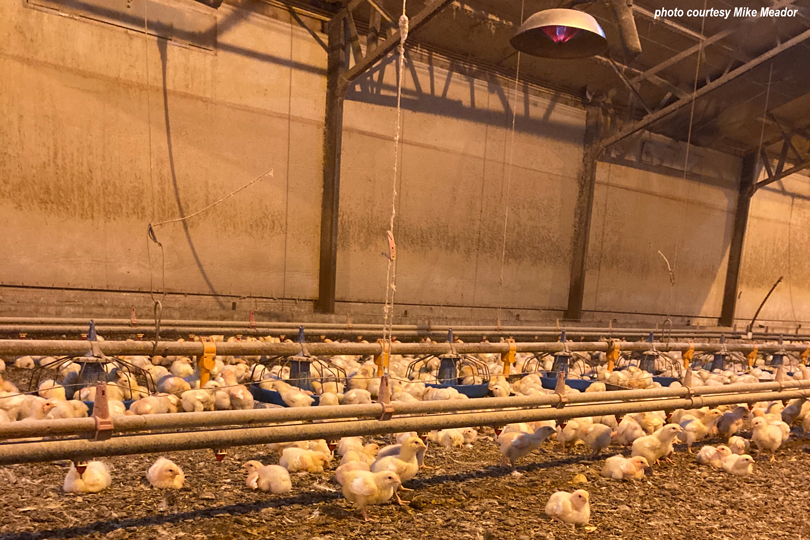
David Alders
In Nacogdoches County, poultry grower David Alders said he was facing one of his worst nightmares amidst the brutally cold weather.
“We had a confluence of factors. Lack of power was a big one. At my farm, we lost power that Tuesday morning through Sunday evening and were running exclusively on generators to keep the water well, heaters, fans and computer systems going,” he said. “It was hard not knowing if we had adequate fuel supplies.”
The feed mill was also unable to operate, causing poultry farmers across the region to run out of feed.
“I had birds between four and five weeks old, and we had a real problem getting food to them. Starting on Monday, I went with a pretty severe rationing program where I just ran feed two or three times a day and didn’t leave it on at all. Normally, it’s free choice where they can eat as much as they want,” Alders said. “On Tuesday, I ran completely out at one house and we had to carry feed by bucket from other houses to that one, which is no easy task to start with and then adding in the cold weather and loss of power…it was pretty miserable.”
Alders ran completely out of feed on Thursday, and he felt helpless.
“If a boiler goes down in the feed mill, which is apparently what happened at one point last week, they’re not able to produce the amount of feed we need. It took from Thursday until that next Tuesday at noon before I got any feed delivered. As growers, we have birds up to nine weeks of age, so when the power comes back on there’s an incredible pent-up demand for all the feed mills can produce,” he said. “They delivered 150,000 pounds, or three semi-truck loads, of feed to me. That’s not an amount of feed you could buy from a feed store and haul back home in your pickup, even if the roads were passable.”
The good news is Alders didn’t have any chickens starve. There was a decent supply of feed and insects in the bedding scattered on the floors for the chickens to scavenge, which is natural chicken feeding behavior. But the lack of normal rations most likely stunted their growth.
“I haven’t heard yet whether we’ll keep them back a few more days to give them time to reach their target weights or not, but that’s a pretty likely scenario,” he said.
High gas bills are another impact he’ll soon face.
“This bad weather is going to severely impact my bottom line. I don’t know what my gas bill is going to be, but it’s probably three or four times what it would be normally because the heat never cut off for five or six days straight,” he said. “We ran heat continuously for a solid seven days. That’s an extreme gas usage. I’d estimate fuel losses will be in the range of five figures—$10,000 or more probably.”
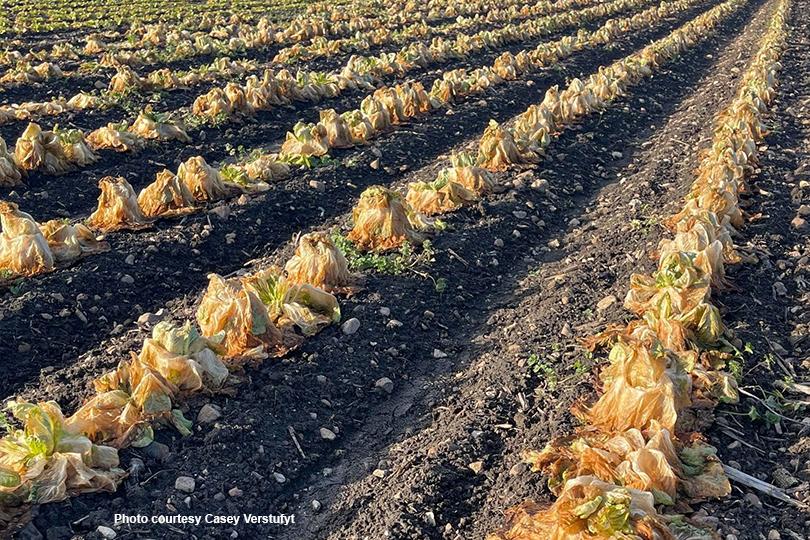
Mark Verstufyt
Once beautiful and green, rows of lettuce now sit wilted and brown in Mark Verstufyt’s field in Bexar County. The lettuce, another crop damaged by the frigid temperatures and snow, was close to harvest.
Many vegetable and fruit farmers are facing a total loss of the last of their cold weather crops, which still had several weeks of production before the spring season set in.
Although the lettuce isn’t salvageable, Verstufyt’s cattle did make it through the storm.
“We never hauled so much hay,” he said. “We fed cubes, had molasses tubs, fed square-baled peanut hay, which has a lot of protein. But when it gets that cold for that many hours and it’s wet, it’s hard on the animals, hard on the crops.”
He can’t remember it being this bad since 1985 when they had 13 inches of snow.
They suffered losses, but Verstufty is still optimistic.
“We have our health, and we’re still here. That’s the main thing,” he said. “Everyone had issues across the state, but somehow, it’ll all work out in the end.”
And when the snow melted, it added a little more moisture to the fields, a blessing with planting season now underway.
“When the snow finally melted, it didn’t run out of the field. So, that helps. We have more moisture to help with planting,” he said.
The silver lining to a disastrous week for Texas agriculture.
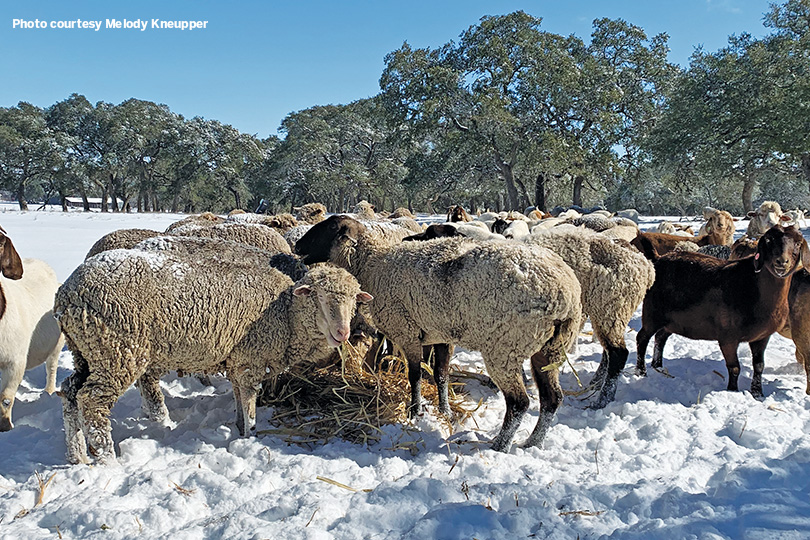
Melody Kneupper
“The first night was probably the worst,” Melody Kneupper said.
She and her husband, Cody, raise sheep, goats and cattle in Kendall County.
That first night they were worried about their livestock and what the rest of the week would bring. How cold would it get? Did they do enough to prepare? Could they get everything done each day?
With determination and faith, they did.
“We were feeding our cows, sheep and goats every other day before it snowed, because we knew our livestock needed to be warm and in as good of shape as possible,” she said.
Their efforts proved beneficial. Their teamwork helped them complete the chores each day, and all their livestock made it through the storm and below-freezing temperatures.
The windy and hilly roads of the Hill Country proved difficult to navigate when covered with snow and ice, but the Kneuppers braved the treacherous conditions to care for their livestock. And those that belong to their neighbors, too.
“We had to help out our neighbors. We have one who lives in Austin, and he has goats, cattle and sheep,” she said. “So, we were feeding for him, because there was no way he could make it from Austin.”
That’s just what ranchers and Texans do. They help each other.

Weathering the storm
The snow is melted, but the memories and experiences are still fresh.
While the extent of Winter Storm Uri’s damage to Texas won’t be known for several months, or maybe even years, farmers and ranchers are moving forward. One calf, one lamb, one seed at a time.
There are many stories of resilience, compassion and devastation across the Lone Star State.
Additional information about disaster assistance programs can be found at texasfarmbureau.org/winter-storm-resources.

